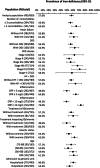Prevalence of iron deficiency in patients admitted to a geriatric unit: a multicenter cross-sectional study
- PMID: 38287253
- PMCID: PMC10826072
- DOI: 10.1186/s12877-024-04719-6
Prevalence of iron deficiency in patients admitted to a geriatric unit: a multicenter cross-sectional study
Abstract
Background: Iron deficiency (ID) is often associated with other comorbidities in older patients and is a factor of morbimortality. However, the prevalence of ID remains poorly documented in this population.
Methods: The CARENFER PA study was a French multicenter cross-sectional study whose objective was to evaluate ID in patients (> 75 years) admitted to a geriatric unit. The primary endpoint was the ID prevalence defined as: serum ferritin < 100 µg/L and/or transferrin saturation coefficient (TSAT) < 20%. The Short Physical Performance Battery (SPPB) test was used to identify older patients at high risk of adverse events (e.g., disability, falls, hospitalization, death).
Results: A total of 888 patients (mean age, 85.2 years; women, 63.5%) from 16 French centers were included from October 2022 to December 2022. The prevalence of ID was 57.6% (95% CI, 54.3-60.9) in the cohort of older patients (62.6% in anemic and 53.3% in non-anemic patients; p = 0.0062). ID prevalence increased significantly with the presence of more than three comorbidities (65.6% vs. 55.9%; p = 0.0274), CRP ≥ 12 mg/L (73.0% vs. 49.3%; p < 0.001) and treatment that may influence ID/anemia (60.5% vs. 49.6%; p = 0.0042). In multivariate analysis, only CRP ≥ 12 mg/L was an independent predictive factor of ID (odds ratio, 2.78; 95% CI, 1.92-4.08; p < 0.001). SPPB scores were low (0-6) in 60.5% of patients with ID versus 48.6% of patients without ID (p = 0.0076).
Conclusion: More than half of older patients had ID, including non-anemic patients. ID was associated with the presence of inflammation and a low SPPB score.
Trial registration: NCT05514951.
Keywords: Anemia; Intravenous iron; Iron deficiency; Older patient; Serum ferritin; Transferrin saturation.
© 2024. The Author(s).
Conflict of interest statement
B. Fougère: consultancies, honoraria, advisory board, speakers: AstraZeneca, Bayer, Biogen, Biophitys, BMS, Boehringer-Ingelheim, CSL Vifor, GSK, MSD, Nestlé, Novartis, Pfizer.
F. Puisieux: consultancies, honoraria, advisory board, speakers’ fees: Bayer, BMS, Boehringer-Ingelheim, CSL Vifor, GSK, MSD, Sanofi, Novartis, Pfizer.
P. Chevalet: speaker’s fees for Vifor.
C. Annweiler: no conflict of interest.
E. Michel: no conflict of interest.
L. Joly: no conflict of interest.
F. Blanc: no conflict of interest.
A. El Azouzi: no conflict of interest.
V. Desré-Follet: employee of CSL Vifor, France.
P. Cacoub: consultancies, honoraria, advisory board, speakers’ fees: Alnylam, Innotech, Mylan, Pfizer, Servier, and Vifor.
Figures
References
Publication types
MeSH terms
Associated data
LinkOut - more resources
Full Text Sources
Medical
Research Materials
Miscellaneous



